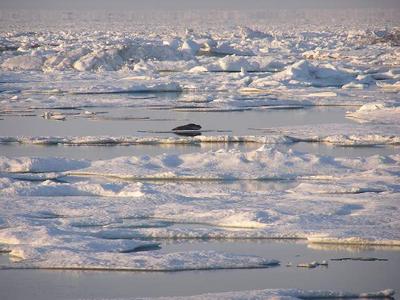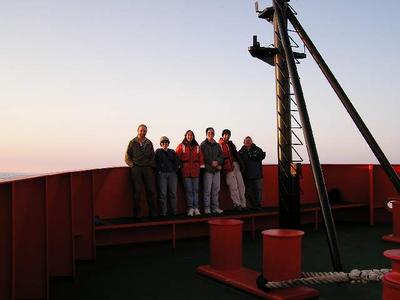22 July, 2003
From our fearless leader:
Chief Scientist's Report #3
R/V Nathaniel B. Palmer SBI Survey Cruise
23 July 2003
James H. Swift
23 July 2003, ca. 2:00 pm Alaska time - from R/V Nathaniel B. Palmer
on the Chukchi Slope
We continue our Shelf-Basin Interactions survey cruise, mostly
following the plan made before the cruise.
We have now completed two long, high-resolution sections across the
Beaufort shelf and slope well into the deep Canada Basin. Both were
east of Barrow Canyon, the principal bathymetric cut from the deep
ocean into the Chukchi shelf in US waters. Both shelf-basin sections
showed a narrow zone of high-oxygen water throughout most of the
water column sited over the same isobath. Other measured
characteristics were also distinctive in this zone.
It was thus with heightened interest that we began our Barrow Canyon
survey of four high-resolution cross-canyon sections. The first was
across the mouth of the canyon, and the second, occupied one tidal
cycle later, was approximately 50 km up-canyon, with the other two
sections each an additional 50 km up-canyon. These proved to be
interesting sections from an oceanographic standpoint, each clearly
exhibiting a zone of water similar to the distinctive water seen a
few days earlier over the Beaufort Slope, the inference being that we
were tracing the core of this year's version of the Barrow Canyon
early summer outflow, first observing it over the Beaufort slope,
then progressively up the canyon, and hopefully (as the cruise
progresses in future weeks) at its source region on the Chukchi
shelf. There is more to the story: we have observed features which
might be interpreted as the shelf outflow water entering the upper
reaches of Barrow Canyon on the west side, and then being pushed over
to the east side, presumably by rotational effects.
Meanwhile, back in the hangar, the marine mammal group rejoiced over
a brilliant turn in the weather, with several sparkling days in a
row, which with other reasonable weather days provided fine flying
conditions. They have now made seven aerial surveys with the
helicopter over ice habitats in the basin and shelf zones. They
encountered low densities of ringed and bearded seals, with higher
densities of bearded seals over the shelf in the marginal ice zone.
They also observed numerous groups of walrus at the ice edge, and
have spotted beluga whales near the shelf slope. They are very
pleased with the helicopter and ship support and - as it has turned
foggy again - eagerly await continuing their flights.
Speaking of flying weather, good flying conditions coincided with
proximity to Barrow, so we bade farewell to Community Parcticipant
Chuck Menadelook (from Little Diomede), who was flown ashore. The
helicopter returned with Luther Leavitt, Jr., from Barrow, who is now
enjoying life and science at sea with us.
Today we are working our third shelf-slope-basin section, this time
west of Barrow Canyon. We have completed 104 stations, and have
experienced very few problems. The pace of the work for the CTD
console & sampling team varies, but the analysts (especially Susan
Becker, our nutrient chemist) are continually faced with daunting
workloads.
We face heavy ice from time to time, but the pack has been loose
enough that Captain Joe and his officers can work their way through
it. Their performance, along with that of the entire ECO and Raytheon
staffs, continues to be exemplary. We find it takes time to meet the
engineering staff in parcticular because they keep everything working
so well that they are rarely called upon on the science deck. The
Palmer is a beautifully maintained research vessel, and a pleasure to
be aboard.
We see polar bears from time to time and the other day had a fine
photo opportunity with a mother walrus and her impressively large
pup. But pretty much it's work, work, work, and in that regard we see
early glimpses of a coherency of results that hopefully will provide
the SBI science team with ample grist for their mill of ideas.
All is well.

Bearded Seal. Note "ice cliff" mirage on the horizon due to light refraction through dense layer of cold air just above the surface of the ice.

Pomarine Jaeger, a predatory seabird, flies by.

Wildlife watching from the Palmer's bow. From left to right: Jim Waters, Heather Smith, Stephanie Moreland, Jim Swift, Leopoldo Llinas, and Kathleen Gavahan.
Contact the TEA in the field at
.
If you cannot connect through your browser, copy the
TEA's e-mail address in the "To:" line of
your favorite e-mail package.
|
